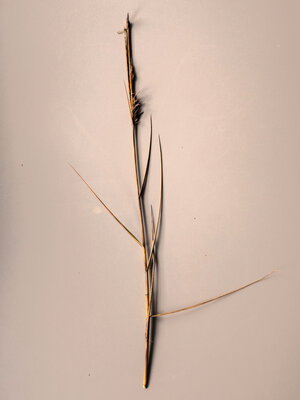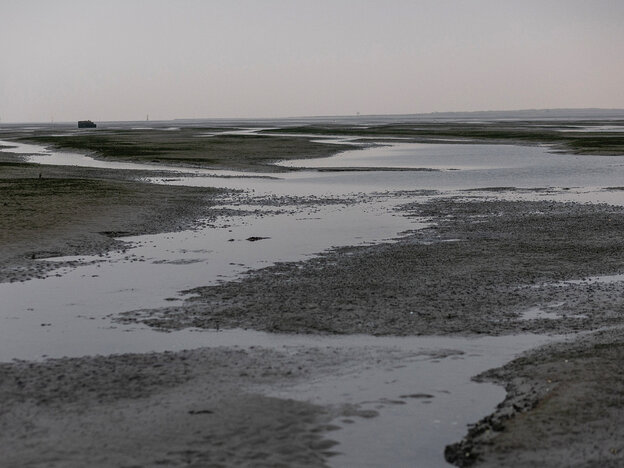Coastal protection with salt marshes: A herb grows against the tide
[ad_1]
The sea level is rising and with it the risk of storm surges. On Spiekeroog, researchers are investigating how salt marshes can protect coasts.
At what wave force does the salt muddy grass break? To do this, researchers collect plant samples Photo: Hannah Aders
SPIEKEROOG taz | Water splashes against the ferry’s porthole as it rocks towards the harbor on the East Frisian island of Spiekeroog. In the dim light, the passengers gather below deck. Kara Keimer talks to her colleagues about her plans on the island.
For a year now she has been going to Spiekeroog for four days every month to collect data for her doctorate at the University of Braunschweig. The 29-year-old environmental engineer is researching how salt marshes, a natural landscape between sea and land, can help protect coastlines despite rising sea levels.
In the “Good Coast Lower Saxony” project, researchers are investigating how natural ecosystems can be included in coastal protection. Because in contrast to classic coastal protection structures such as dykes or flood protection walls, salt marshes not only protect the coast in a natural way, but also the climate.
Keimer is prepared for the gray November days on the island. She wears sturdy shoes and an anorak with a neon orange hood. She has tied her hair in a ponytail. On the way from the ferry to the Wittenbülten National Park House, where the researchers can sleep and use the laboratory, the island shows itself from its most beautiful side: on the left you can see sandy dunes, on the right the North Sea murmurs on the horizon. A landscape increasingly threatened by the climate crisis.
Coastal regions in the climate crisis
Spiekeroog is still three meters above sea level. But it is increasing – by almost 20 centimeters in the last century. The Intergovernmental Panel on Climate Change assumes that the increase will accelerate in the future. The main reasons for the increase are the melting ice masses in Greenland and Antarctica. Also, as the water in the oceans warms up, it expands. Even if greenhouse gas emissions are curbed, an increase of up to 90 centimeters by the year 2150 can be expected.
As a result, coastal regions around the world are increasingly having to contend with major challenges. This also applies to the East Frisian Islands, to which Spiekeroog belongs. Due to the higher water levels and stronger wave energy, the sea is eating its way further and further inland. Storm surges are becoming stronger and more frequent. Saltwater penetrates the groundwater and thus endangers the drinking water supply and agricultural use in the regions.
Current protective measures such as dykes and walls may no longer provide sufficient protection in the future. Renovating them and adapting them to the rising water levels is very expensive: In 2020, the Lower Saxony Ministry of the Environment provided over 60 million euros for investments in coastal protection, for example to make the dikes safer.

The salt marsh grass is one of more than 45 plant species of the salt marsh Photo: Thea Marie Klinger
This is where the herbaceous landscape between sea and land that Kara Keimer examines can help. It serves as a buffer zone between the sea and the dike. Waves are slowed down and lose energy as a result. As a result, the waves are getting smaller and dykes don’t have to be built as high. This could save millions.
Salt marshes have already proven their worth as protection against storm surges during the flood of the century in 1953, which hit the Dutch, English and Belgian coasts in particular. Scientific calculations determined that the salt marshes in front of the dikes ensured that they broke through less deeply.
Salt marshes preserve biodiversity
This is mainly due to the more than 45 plant species that grow on the salt marshes. Above ground, their stalks slow down incoming waves, and their roots stabilize the ground. In winter, when the storm surges become most dangerous, two plants are particularly dominant: the salt marsh grass and the creeping couch grass. They grow over a meter tall and look like grain on the mud flats. Keimer prefers the Latin names: Spartina anglica and Elymus. She is investigating these two species for her doctorate. But before the researcher can analyze the plants in the laboratory, she has to go to the salt marshes and collect samples.

This text is from the weekly. Our weekly newspaper from the left! Every week in the Wochentaz, the world is about how it is – and how it could be. A left-wing weekly newspaper with a voice, attitude and the special taz view of the world. Every Saturday new at the kiosk and of course by subscription.
It’s quiet on the island as Keimer and her student worker sneak out of the house. Around seven o’clock they meet nobody on the island. The two have a long day ahead of them. They walk along a narrow path in rubber boots, where every step they take smacks in the mud. In the twilight, hardly any colors can be seen. The path winds past tufts of grass and through mud puddles, one wrong step and you can sink knee deep into the ground. But the two are familiar with the path.
Due to the frequent flooding of the salt marshes with seawater, the soil here has a very high salt content. Plants such as salt marsh grass or creeping couch grass have developed special strategies to survive in spite of the high levels of salt. “In the summer the salt marshes look beautiful – everything blooms,” says Kara Keimer. In November, the blades of grass present a rather dreary picture and blur into a grey-brown area.
They are a particularly valuable habitat for flora and fauna: redshank and brent goose are just two of the approximately 50 bird species that use the salt marshes for breeding, resting or as a feeding ground. And about 1,650 species of crawling animals such as the yellow meadow ant or the magnificent salt beetle also live here.
At the same time, overgrown coastal systems such as salt and seagrass meadows or mangrove forests make a significant contribution to climate protection, as they release CO2 absorb from the atmosphere. The carbon dioxide is converted into organic material and stored in biomass, soil and sediment. The watery, low-oxygen soils slow down the breakdown of organic matter – and thus prevent the CO2 returned to the atmosphere. Due to the special importance of these coastal systems for the carbon cycle, the term “Blue Carbon” has been established in science.

What looks muddy gray is the habitat of over 1,600 species Photo: Hannah Aders
“I’ll take a look at the buoy,” Keimer calls out to her colleague and continues towards the sea. The two do not exchange many words. As a well-established team, they know the processes. While he crouches in the meadow and begins to snip off individual stalks with the secateurs, she runs to the edge of the water. One puddle follows the next on the sandy ground, the air smells muddy. Germer stops. She spotted the unassuming little plastic box attached to an anchor with fishing line – the mini buoy.
When the tide comes in and washes over the meadow, a sensor in the buoy measures how long it is under water. Depending on the weather conditions and time of the year, it can be several hours a day or no flooding for days. Each time the waves roll across the salt marsh, they bring with them small particles of sediment that settle and form a layer of fine mud.
As a result of this process, the salt marshes grow a little higher every year. They grow up to one centimeter in twelve months. So they are rising – as is sea level. However, it is still unclear whether they can keep up with the water.
With stiff blades against the waves
It is all the more important to understand nature-based coastal protection. As a natural island, Spiekeroog is particularly suitable for this. Because nature can only react to its environment where it can develop freely. In contrast to beaches, where people have placed one building next to the next, nature has room on the small North Sea island. Not only are the salt marshes sprouting up on Spiekeroog, but the extensive dune landscape that Keimer’s colleagues are investigating is also growing. They form a bulwark against the storm and also serve as a habitat for numerous animal and plant species that prefer to remain undisturbed.
Back in the lab, Keimer cuts the collected stalks into pieces eight centimeters long. She wants to know what force the stalks can withstand in order to find out at what wave force they break. To measure this, she places the plant fragments on a material testing machine. It measures flexibility – or stiffness, as the researcher calls it – from the base of the plant to the top. For several hours she persistently puts snippet after snippet on the machine, in between she keeps reaching for biscuits and gummy bears behind her.
Keimer and her colleagues want to use the results to better understand how the plants interact with the sea: “If we analyze the plants mechanically, we can better understand the interactions between the waves and the vegetation,” she says.
Using plant models that they recreate in the laboratory and artificially generated waves, they can simulate how the water flows around the plants – and how the vegetation affects the waves. They learn from salt marsh grass and creeping couch grass how the coast can be protected and how salt marshes can be better integrated into coastal protection in the future. In places in the Lower Saxony Wadden Sea it can already be observed that natural salt marshes are forming on artificially created salt marshes.
[ad_2]
Original Source Link






